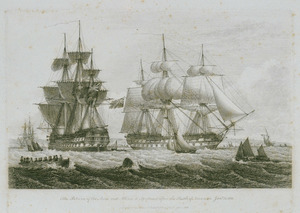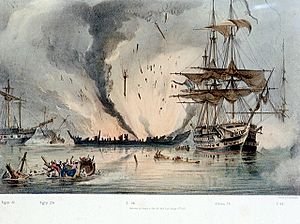HMS Albion (1802) facts for kids

The Return of the Asia and Albion to Spithead after the Battle of Navarino, 31 January 1828
|
|
Quick facts for kids History |
|
|---|---|
| Name | HMS Albion |
| Ordered | 24 June 1800 |
| Builder | Perry, Wells & Green, Blackwall Yard |
| Laid down | June 1800 |
| Launched | 17 June 1802 |
| Honours and awards |
|
| Fate | Broken up, 1836 |
| General characteristics | |
| Class and type | Fame-class ship of the line |
| Tons burthen | 1740+32⁄94 bm |
| Length | 175 ft (53 m) (gundeck) |
| Beam | 47 ft 6 in (14.48 m) |
| Depth of hold | 20 ft 6 in (6.25 m) |
| Propulsion | Sails |
| Sail plan | Full-rigged ship |
| Armament |
|
HMS Albion was a powerful 74-gun ship of the line in the Royal Navy. This type of ship was a large warship with many cannons, designed for battles in a line formation. Albion was built at Blackwall Yard on the River Thames and was launched on 17 June 1802. She served the British Navy for many years before being taken apart in 1836.
Contents
Albion's Role in the Napoleonic Wars
In May 1803, HMS Albion joined Admiral Cornwallis' fleet. Their important job was to blockade, or block off, the French naval port of Brest. This prevented French ships from leaving or entering the port.
Adventures in the Indian Ocean
Soon after, Albion was sent to the Indian Ocean. She spent several years there, protecting British interests and trade routes.
Capturing a French Privateer
On 21 December 1803, Albion and another British ship, Sceptre, captured a French privateer named Clarisse. Privateers were private ships allowed by their government to attack enemy merchant ships. Clarisse had 12 guns and 157 crew members. She was planning to attack ships in the Bay of Bengal but was caught before she could cause any trouble.
Escorting Merchant Ships
In February 1804, Albion and Sceptre met a fleet of East Indiamen ships. These were large merchant ships that carried valuable goods from India. The British warships safely escorted these important ships to Saint Helena, and then another ship took them on to England.
Later, in 1808, Albion helped recapture a ship called Swallow, which was carrying gold dust. She also escorted another group of nine East Indiamen back to Britain. However, a big storm scattered the fleet, and three of the merchant ships were lost at sea.
Service in the War of 1812
After a long time being repaired, Albion became the flagship for Rear Admiral George Cockburn in 1814. She took part in the War of 1812 against the United States.
Operations in Chesapeake Bay
During the summer of 1814, Albion was part of a force that patrolled the coastline of Chesapeake Bay. She sailed up the Potomac and Patuxent Rivers. Her crew destroyed many American ships and government buildings. These operations continued until peace was declared in 1815.
Post-War Engagements
Just one year after the War of 1812, Albion was involved in another major event.
Bombardment of Algiers (1816)
On 27 August 1816, Albion joined a combined British and Dutch fleet. Their mission was to bombard Algiers (a city in modern-day Algeria). The goal was to force the Dey of Algiers (the ruler) to free Christian slaves. Albion fired over 4,000 shots at the city. She suffered some damage and had 3 crew members killed and 15 wounded.
In 1827, Albion was part of a combined British, French, and Russian fleet. This fleet, led by Admiral Codrington, fought in the Battle of Navarino. They completely destroyed a Turkish-Egyptian fleet. This victory was very important because it helped Greece gain its independence. During this fierce battle, Albion had 10 crew members killed and 50 wounded.
In 1847, a special medal called the Naval General Service Medal was given to surviving sailors who fought in the battles of "Algiers" and "Navarino."
Albion's Final Years
In 1831, Albion was converted into a hulk. A hulk is an old ship that is no longer seaworthy and is used for other purposes, like a floating prison or, in Albion's case, a quarantine ship. She was finally taken apart, or "broken up," in 1836.



